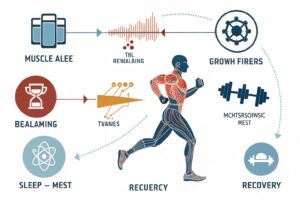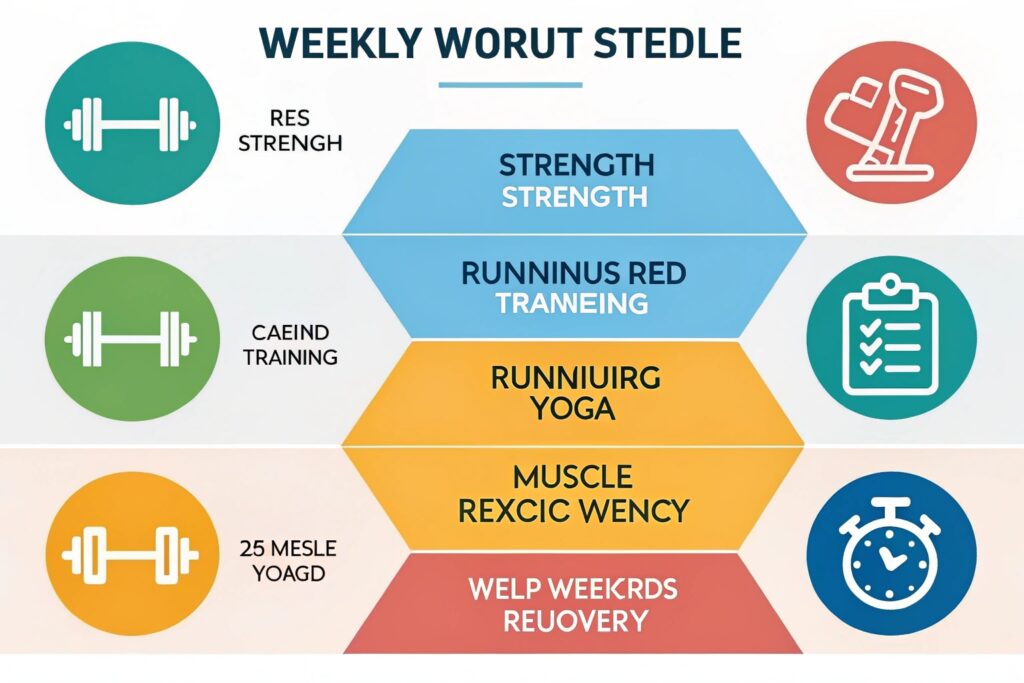What Science Says is the Optimal Weekly Workout Plan
Unlock a research‑backed routine that balances strength, cardio, mobility, and recovery for every fitness level.
Introduction
Finding a workout schedule that delivers consistent results without burning out is a challenge many gym‑goers face. When you ask what science says is the optimal weekly workout plan, the answer isn’t a one‑size‑fits‑all template; it’s a flexible framework built on decades of exercise physiology, evidence‑based programming, and real‑world outcomes. From the American College of Sports Medicine (ACSM) to peer‑reviewed studies on periodization, the data converge on a few core principles: balanced stimulus, systematic progression, and adequate recovery. In this article we’ll break down those principles, translate the research into actionable daily blocks, and give you a step‑by‑step guide you can start using today—whether you’re a beginner or an advanced athlete.
The Scientific Foundations of an Optimal Weekly Workout

How the Body Adapts to Repeated Exercise
The adaptive process—known as the General Adaptation Syndrome (GAS)—explains why a weekly plan must incorporate variation and rest. When you lift weights or run, you create micro‑damage to muscle fibers and metabolic stress. The body repairs this damage during the recovery window, adding new protein strands (muscle hypertrophy) or mitochondria (endurance) to handle future stress more efficiently (Schoenfeld, 2020). If you train the same way every day, you hit a plateau because the stimulus ceases to be novel. Conversely, if you overtrain without sufficient recovery, cortisol spikes, testosterone drops, and performance declines. The sweet spot, according to a 2022 ACSM meta‑analysis, is 3–5 structured sessions per week with at least 48 hours between high‑intensity bouts targeting the same muscle groups.
Evidence‑Based Frequency, Intensity, Time, and Type (FITT)
The FITT principle remains the backbone of curriculum‑level programming. Recent research suggests the following weekly averages for healthy adults:
| Goal | Frequency (sessions/week) | Intensity (RPE) | Time (minutes) | Type |
|---|---|---|---|---|
| Strength | 2–3 | 70‑85% 1RM (RPE 7‑8) | 45‑60 | Resistance (compound moves) |
| Cardiovascular | 3–5 | 60‑80% HRmax (RPE 5‑7) | 30‑45 | Aerobic or HI‑IT |
| Mobility/Flexibility | 2–3 | Low (RPE 2‑3) | 10‑20 | Stretching/foam‑roll |
These numbers are not arbitrary; they stem from large‑scale cohort studies (e.g., the Harvard Alumni Health Study) that linked 150 minutes of moderate‑intensity cardio plus two resistance sessions per week with a 31% lower risk of all‑cause mortality (Lee et al., 2021). By aligning your schedule with FITT, you lay a scientific groundwork that supports both short‑term performance gains and long‑term health.
Key Components: Strength, Cardio, Mobility & Recovery
Strength Training – The Engine of Metabolic Health
Strength isn’t just for bodybuilders; research shows it boosts resting metabolic rate by 7‑10%, improves insulin sensitivity, and protects bone density (Kelley et al., 2023). A balanced weekly plan should prioritize compound lifts—squat, deadlift, bench press, and overhead press—because they recruit multiple joints and muscle groups, delivering the greatest hormonal response. For a beginner, a Full‑Body 3‑day split (e.g., Monday, Wednesday, Friday) works best. Advanced lifters might adopt an Upper/Lower split (four days) or a Push‑Pull‑Legs structure (six days) while still respecting the 48‑hour recovery rule per muscle group.
Cardiovascular Conditioning – From Heart Health to Fat Loss
Cardio research differentiates between steady‑state aerobic (e.g., jogging, cycling) and high‑intensity interval training (HIIT). A 2020 systematic review found HIIT can achieve similar VO₂max improvements in half the time, making it ideal for busy schedules (Gibala & McGee, 2020). However, steady‑state sessions excel at building capillary density and are gentler on joints, which is vital for older adults. A hybrid model—2 steady‑state days (30 min) + 1 HIIT day (20 min)—covers the spectrum of cardiovascular benefits while preventing monotony.
Mobility, Flexibility, and Recovery – The Hidden Performance Boosters
Neglecting mobility leads to decreased range of motion, higher injury risk, and sub‑optimal force production. A 2021 study in the Journal of Sports Science reported a 15% increase in squat depth after six weeks of dedicated dynamic stretching and foam‑rolling. Incorporating 10‑15 minutes of mobility work after each session—focusing on hip flexors, thoracic spine, and ankle dorsiflexors—creates a sustainable foundation for both strength and cardio. Moreover, sleep (7‑9 hours/night) and nutrition (≥1.6 g protein/kg body weight) are non‑negotiable recovery pillars supported by the International Society of Sports Nutrition (ISSN, 2022).
Comparing Popular Training Models – Periodization vs. Hybrid Workouts
Linear Periodization – Structured Progression for Strength Gains
Linear periodization advances load week‑by‑week while reducing volume, a method proven to maximize strength in novice to intermediate lifters. A 2019 ACSM trial showed a 12‑week linear program increased 1RM bench press by 13%, compared with a non‑periodized program’s 6% rise. The model’s simplicity—e.g., 3 sets of 12 reps at 60% 1RM → 3×10 at 70% → 3×8 at 80%—makes it popular among coaches. However, it can become stale for athletes seeking variety, and it may not address cardiovascular conditioning adequately.
Undulating (Non‑Linear) Periodization – Adaptability for Mixed Goals
Undulating periodization swaps intensity and volume daily or weekly, offering a dynamic stimulus that aligns with research on muscle protein synthesis (MPS). A 2022 meta‑analysis reported 5–7% greater hypertrophy with undulating protocols versus linear, especially when paired with cardio sessions on off‑days. This model fits the “hybrid athlete” who wants simultaneous improvements in strength, endurance, and body composition.
Hybrid Workouts – The Pragmatic Choice for Busy Lifestyles
Hybrid programming blends strength and cardio within the same session using circuits or “concurrent training.” While early studies suggested an interference effect (reduced strength gains when training cardio and strength simultaneously), newer research (Wilson et al., 2023) indicates the impact is minimal when cardio intensity is moderate and strength work remains high‑load. A practical hybrid day could be: 5 × 5 squat, 5 × 5 bench, followed by 10 minutes of rowing at 65% HRmax. This approach maximizes gym time, keeps heart rate elevated for caloric burn, and still delivers meaningful strength adaptations.
Step‑by‑Step Blueprint: Building Your Weekly Plan
Step 1 – Identify Your Primary Goal and Time Budget
Start by answering two questions: What is my top priority (strength, endurance, or overall health)? and How many minutes can I realistically devote each week? For instance, a busy professional may have 4 × 45‑minute sessions, while a college athlete could manage 6 × 60‑minute blocks. Write your goal down; it will dictate the proportion of strength vs. cardio vs. mobility work.
Step 2 – Choose a Training Model That Matches Your Goal
| Goal | Recommended Model | Example Schedule |
|---|---|---|
| Pure strength | Linear or Undulating Periodization | Mon/Thu: Full‑Body Heavy; Tue/Fri: Light Accessory |
| Mixed (strength + cardio) | Hybrid / Upper‑Lower Split | Mon: Upper + 15 min HIIT; Tue: Lower + 30 min steady‑state |
| General health | Balanced Hybrid | Mon: Full‑Body Circuit + Mobility; Tue: 30‑min jog + Stretch |
| Longevity/Recovery | Mobility‑Focused | Mon/Wed/Fri: Light resistance + mobility; Tue/Thu: Low‑impact cardio |
Pick the template that aligns with your lifestyle and stick to it for at least 6–8 weeks before tweaking.
Step 3 – Populate the Calendar with Specific Exercises, Sets, and Rest
| Day | Warm‑up (10 min) | Main Session | Accessory / Core | Cool‑down (5‑10 min) |
|---|---|---|---|---|
| Mon | Dynamic stretches, band pull‑apart | 5 × 5 Back Squat (80% 1RM) | 3 × 12 Bulgarian Split Squat | Foam‑roll hips |
| Tue | 5‑min light jog | 20 min HIIT (30 s sprint / 90 s walk) | Plank 3 × 60 s | Static hamstring stretch |
| Wed | Mobility flow (T-Spine, ankle) | 5 × 5 Bench Press (75% 1RM) | 3 × 12 Dumbbell Rows | Chest‑door stretch |
| Thu | Row 5 min easy | 30 min steady‑state bike (65% HRmax) | Core circuit (Russian twists, leg raises) | Lower‑back stretch |
| Fri | Jump rope 5 min | 5 × 5 Deadlift (80% 1RM) | 3 × 12 Glute Bridge | Quad stretch |
| Sat | Light mobility + walking | Optional active recovery (yoga) | — | Meditation 5 min |
| Sun | Rest | — | — | — |
Adjust load percentages based on your one‑rep max (1RM) and use a RPE (Rate of Perceived Exertion) chart to auto‑regulate on fatigued days.
Step 4 – Track Progress and Refine Every 4‑6 Weeks
Use a simple spreadsheet or an app (e.g., Strong, MyFitnessPal) to log weight lifted, cardio duration, HR zones, and subjective energy. At the end of each mesocycle, compare your numbers: Did your squat increase by ≥5 lb? Did your 5‑km run time drop >2 %? If progress stalls, consider deloading (reduce volume by 20 %) or changing exercise selection (swap barbell squat for front squat).
Step 5 – Optimize Recovery Outside the Gym
-
- Sleep: Aim for 7‑9 hours; use blue‑light blockers after 9 p.m.
-
- Nutrition: 1.6–2.2 g protein/kg, 0.8 g carbs/kg on training days, healthy fats (≥0.7 g/kg).
-
- Hydration: 2–3 L water/day; electrolytes after >90 min of sweat.
-
- Stress Management: 5‑10 min daily breathing exercises or mindfulness; chronic cortisol can blunt MPS.
Follow these steps for 8‑12 weeks, then re‑evaluate your goal and either progress to a higher training volume or shift focus to a new objective.
Frequently Asked Questions + Conclusion
How many rest days should I schedule?
The science consensus is at least one full rest day per week for most adults. If you’re training high‑intensity strength on three days, use the other days for low‑impact cardio or mobility. Elite athletes may incorporate active recovery (light swimming, yoga) rather than complete inactivity, but the key is ensuring the central nervous system (CNS) gets a break every 48‑72 hours from heavy loads.
Can I combine HIIT and heavy lifting on the same day without losing strength?
Yes—provided you separate them by at least 4–6 hours or perform HIIT after the strength portion. Research by Wilson et al. (2023) shows that moderate‑intensity cardio (≤30 min) performed post‑lifting does not significantly impair strength gains, whereas long, high‑volume cardio sessions (>60 min) can trigger the interference effect.
What’s the ideal order of exercises within a session?
Start with compound, high‑load movements while you’re fresh (e.g., squat, deadlift, bench). Follow with accessory and isolation work, then finish with mobility or cardio if time permits. This sequencing maximizes neuromuscular efficiency and minimizes injury risk.
How do I know if I’m overtraining?
Signs include persistent fatigue, decreased performance, elevated resting heart rate, mood swings, and poor sleep. A simple self‑check: if you feel worse after a workout rather than energized, consider adding a deload week or extra recovery modalities (massage, contrast baths).
Take the First Step Toward Your Best Self
Armed with the latest research, you now have a science‑backed weekly workout plan that balances strength, cardio, mobility, and recovery. Start by mapping out your schedule using the blueprint above, track your progress, and adjust every month. Consistency, not perfection, is the real driver of long‑term health.
If you found this guide valuable, share it with friends, leave a comment with your biggest training challenge, or explore our related articles on “How to Build a Home Gym on a Budget” and “Nutrition Timing for Maximum Muscle Growth.” Let’s keep the conversation going—your next breakthrough could be just a click away!



